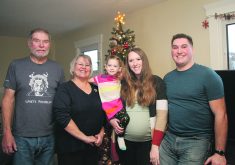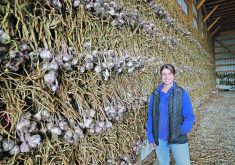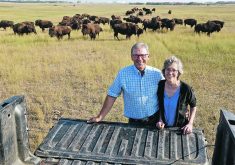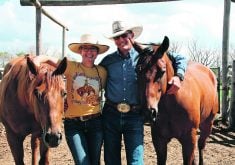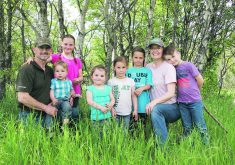On the Farm: The installation of an irrigation pivot made the business possible and a building boom helped it take off
It makes sense that land once covered in grass would produce good grass.
Doug and Lois McGillivray took that chance in the 1990s to add value to their farm south of Regina, establishing a 500-acre sod farm amid their grain and oilseeds operation.
They are now transitioning the successful Prairie Sod Farm to their oldest daughter, Catherine, and her husband, Carlos Quiroz.
Catherine and Carlos, from Venezuela, met at university in the United States where they were both swimmers.
She has a business degree; he is an engineer. Both are now farmers.
“I came home from New York and decided I wanted to be a farmer,” Catherine said.
Carlos took a little more coaxing, confessing he hated his first year working on the farm. But that was eight years ago.
“I love farming,” says Catherine.
“And he loves her,” finishes Lois.
McGillivray Farms is about 7,000 acres in total and the sod farm was possible after an irrigation pivot was installed in 1996. Bratt’s Lake, for which the rural municipality is named, is right across the road.
Read Also

Nutritious pork packed with vitamins, essential minerals
Recipes for pork
The $260,000 cost of the pivot was shared between Doug and his father.
“That was a big decision for him,” Doug recalled. “We could’ve bought land for $500 an acre. My dad had a lot of foresight in going half and half with this centre pivot.”
But they have always had water management issues in the area that irrigating could help alleviate, and they had grown certified grass seed for a couple of years.
It was Lois’s idea to try blue grass.
“I just thought there was a market,” she says.
“She said, ‘you can grow $4 wheat like everyone else or you can try this,’ ” Doug said. “It turns out you can grow grass on the Prairies.”
They planted 10 acres and had their first sod available two years later.
“We sold out by July 15 that first year,” said Lois, a chartered professional accountant.
They had hit the building boom occurring in southeastern Saskatchewan and the business took off.
There were other costs.
“None of the equipment we had crossed over,” Doug said. “At first we were buying other people’s junk because we didn’t know how much to invest.”
But he said they had to spend money on some good equipment because they are dealing with a perishable product.
The sod is constantly seeded and harvested to maintain supply. Mowing it is a full-time job and cutting is done as needed.
There is no crop rotation required, but they were off to buy a plow this fall to rejuvenate some land before re-seeding.
“You need to flip it over,” Doug said.
The farm relies on seven staff through the busy season, including delivery staff.
Catherine and Carlos say they can make a living from the 500 acres. They also bought and rent some farmland but only the sod farm is part of the current transition plan.
The younger couple is the most recent generation to take over land homesteaded by the McGillivray family in 1900. A mile away is the original homestead established in the 1880s.
On the grain side, the McGillivrays grow canaryseed, canola, durum and lentils. This year, on the second day of harvest, one of their combines went up in flames due to a hydraulic oil fire.
Nobody was hurt but it did mean renting a combine to finish off the year.
There are three younger McGillivray siblings, Scott, Megan and Michael, who aren’t involved in the farm business. Scott and Megan both attended university in the United States as swimmers. Michael is headed to a California university to swim after finishing high school this year.
Catherine said it’s too soon to say what the future holds for their farm. Land prices at more than $250,000 for a quarter section make it hard to consider expanding too much. And Carlos said they are still learning in just the first year of taking over.
“I think we’re a nice sustainable unit,” said Doug.
He points to higher chemical bills and more players within agriculture taking a piece of the pie.
“It’s a good thing to be diversified to compete with that,” he said.
Around them, other families have sold their farms and Doug said that’s sad.
“But then there’s no more family farm,” said Catherine.
Lois said she had reservations about Catherine and Carlos taking over the sod side but has changed her mind as it is happening.
“I didn’t want to see them buried in debt,” she said. “Now, they’ve taken over quite nicely so it seems quite doable.”







